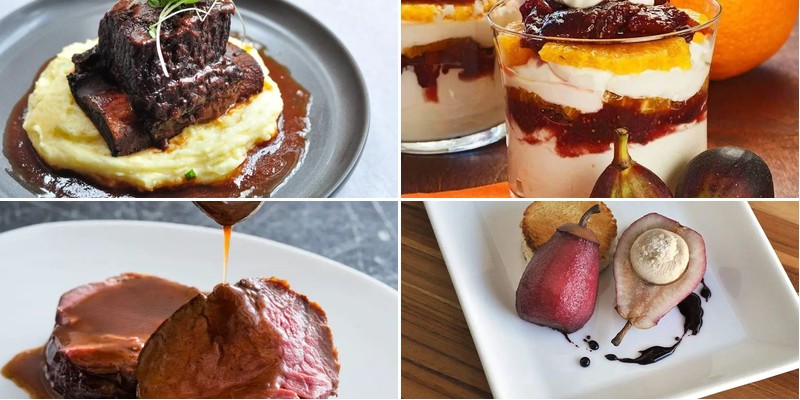Mmm, can you smell that? Rich, velvety port wine simmering into something spectacular. Whether you’re craving cozy comfort food or planning a gourmet dinner party, these 25 port-infused recipes will transform your cooking. From elegant sauces to decadent desserts, get ready to impress your taste buds—and your guests. Let’s dive into these delicious creations that make port the star of your kitchen!
Port Wine Braised Short Ribs
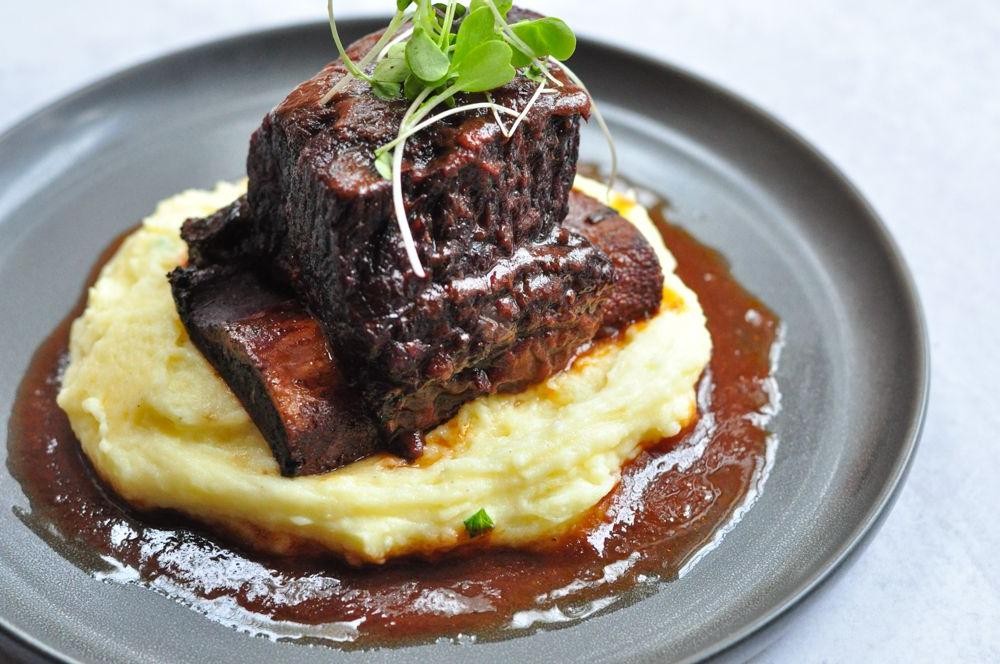
Wrapped in the deep, aromatic embrace of port wine, these braised short ribs transform humble ingredients into a sophisticated centerpiece worthy of any autumn gathering. The slow, gentle cooking process coaxes out incredible tenderness while building layers of complex flavor that will have your kitchen smelling like a professional bistro. Perfect for a cozy dinner party or a special family meal, this dish elevates comfort food to an art form.
2
servings25
minutes210
minutesIngredients
Short ribs – 4 lbs
Salt – 2 tsp
Black pepper – 1 tsp
Flour – ¼ cup
Olive oil – 2 tbsp
Yellow onion – 1 large, chopped
Carrots – 2 medium, chopped
Garlic – 4 cloves, minced
Port wine – 1 cup
Beef broth – 2 cups
Thyme – 4 sprigs
Bay leaves – 2
Instructions
1. Pat the short ribs completely dry with paper towels and season all sides evenly with salt and black pepper.2. Dredge each short rib in flour, shaking off any excess to ensure a light, even coating.3. Heat olive oil in a large Dutch oven over medium-high heat until it shimmers, about 2 minutes.4. Sear the short ribs in batches, cooking for 4-5 minutes per side until deeply browned with a crisp crust.5. Remove the short ribs and set aside, then reduce heat to medium.6. Add the chopped onion and carrots to the pot, sautéing for 6-8 minutes until softened and lightly caramelized.7. Stir in the minced garlic and cook for 1 minute until fragrant but not browned.8. Pour in the port wine, scraping the bottom of the pot with a wooden spoon to release all the flavorful browned bits.9. Simmer the port wine for 3-4 minutes until reduced by half and slightly thickened.10. Return the short ribs to the pot along with any accumulated juices.11. Add the beef broth, thyme sprigs, and bay leaves, ensuring the liquid comes about three-quarters up the sides of the meat.12. Bring the liquid to a gentle simmer, then cover the pot and transfer to a preheated 325°F oven.13. Braise for 2.5-3 hours until the meat is fork-tender and easily pulls away from the bone.14. Carefully remove the short ribs from the pot and tent with foil to keep warm.15. Skim the excess fat from the surface of the cooking liquid using a spoon or fat separator.16. Simmer the remaining sauce over medium heat for 8-10 minutes until reduced to a rich, glossy consistency.17. Discard the thyme sprigs and bay leaves before serving.Keep in mind that the quality of port wine significantly impacts the final flavor—opt for a ruby port for its fruit-forward character that beautifully balances the richness of the beef. Knowing when the ribs are perfectly cooked is simple: the meat should offer no resistance when pierced with a fork and nearly fall off the bone with gentle pressure. For an elegant presentation, serve these luxurious short ribs over creamy polenta or buttery mashed potatoes to soak up every drop of the deeply flavored sauce, creating a harmonious balance of textures and tastes that feels both rustic and refined.
Roasted Duck with Port Cherry Sauce
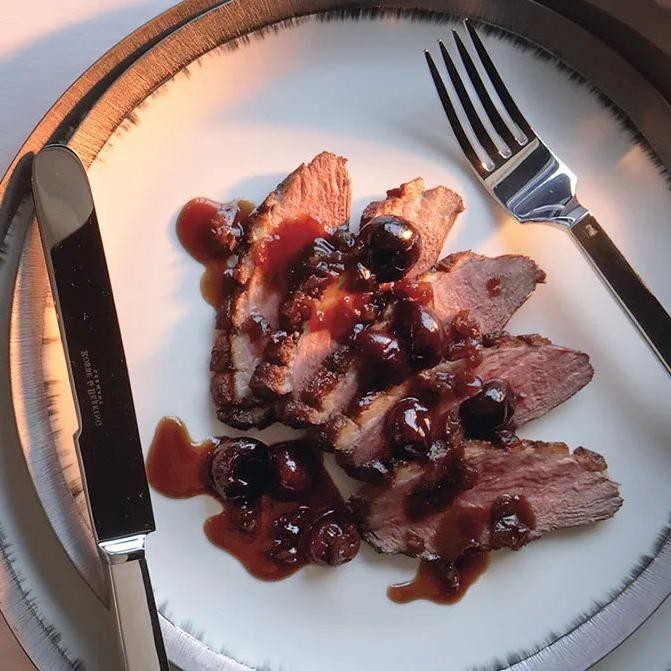
Heralding the arrival of autumn’s bounty, this roasted duck with port cherry sauce transforms humble ingredients into an extraordinary centerpiece. The rich, crisp-skinned bird glistens with a glossy reduction that balances sweet and savory notes. Perfect for intimate dinners or holiday gatherings, it elevates any occasion with its sophisticated flavors.
5
servings15
minutes140
minutesIngredients
– Whole duck – 5-6 lb
– Salt – 1 tbsp
– Black pepper – 1 tsp
– Port wine – 1 cup
– Dried cherries – ½ cup
– Chicken broth – 1 cup
– Butter – 2 tbsp
Instructions
1. Preheat your oven to 350°F.
2. Pat the duck completely dry with paper towels inside and out.
3. Score the duck skin in a crosshatch pattern, being careful not to cut into the meat.
4. Rub the salt and black pepper evenly over the entire surface of the duck.
5. Place the duck breast-side up on a rack in a roasting pan.
6. Roast for 2 hours until the skin is golden brown and crisp.
7. Check the internal temperature with a meat thermometer—it should read 165°F in the thickest part of the thigh.
8. Remove the duck from the oven and let it rest for 20 minutes before carving.
9. While the duck rests, combine the port wine and dried cherries in a saucepan over medium heat.
10. Simmer for 8-10 minutes until the cherries plump and the liquid reduces by half.
11. Add the chicken broth and continue simmering for another 10 minutes.
12. Whisk in the butter until the sauce becomes glossy and slightly thickened.
13. Strain the sauce through a fine-mesh sieve, pressing on the cherries to extract their flavor.
14. Carve the duck and serve immediately with the warm port cherry sauce. Buttery crisp skin gives way to succulent, tender meat that pairs beautifully with the sophisticated sauce. The tart cherries cut through the duck’s richness, while the port adds depth and complexity. For an elegant presentation, serve alongside roasted root vegetables or a simple wild rice pilaf.
Port Glazed Pork Tenderloin
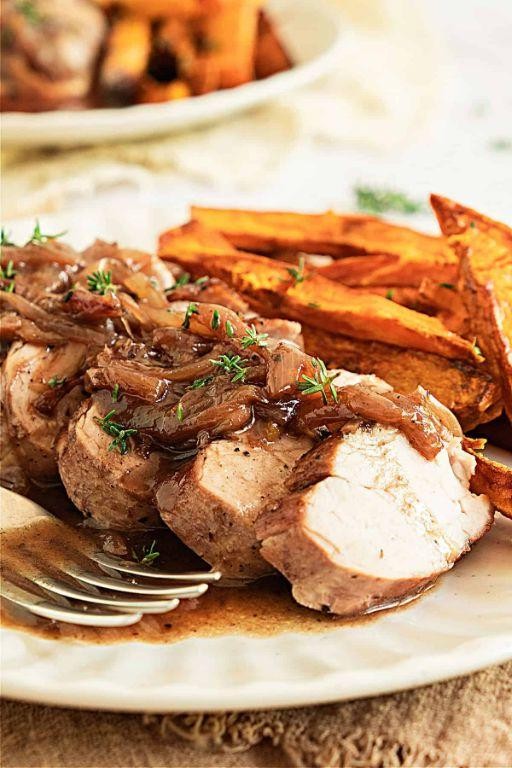
Meticulously balancing sweet and savory notes, this port glazed pork tenderloin transforms an elegant cut into a showstopping centerpiece. The rich reduction creates a glossy, caramelized crust that locks in the tenderloin’s natural juices. Perfect for both weeknight dinners and special occasions, it delivers restaurant-quality sophistication with surprisingly simple preparation.
3
servings10
minutes30
minutesIngredients
Pork tenderloin – 1 ½ lbs
Port wine – ¾ cup
Brown sugar – 2 tbsp
Dijon mustard – 1 tbsp
Olive oil – 1 tbsp
Salt – 1 tsp
Black pepper – ½ tsp
Instructions
1. Preheat your oven to 400°F and position a rack in the center.
2. Pat the pork tenderloin completely dry with paper towels to ensure proper browning.
3. Rub the tenderloin evenly with olive oil, then season all sides with salt and black pepper.
4. Heat an oven-safe skillet over medium-high heat for 2 minutes until hot.
5. Sear the tenderloin for 2 minutes per side until golden brown on all surfaces.
6. Transfer the skillet directly to the preheated oven and roast for 15 minutes.
7. Meanwhile, combine port wine, brown sugar, and Dijon mustard in a small saucepan.
8. Bring the glaze mixture to a boil over medium heat, then reduce to a simmer.
9. Simmer the glaze for 8-10 minutes, stirring occasionally, until reduced by half and syrupy.
10. Remove the pork from the oven when its internal temperature reaches 145°F on an instant-read thermometer.
11. Transfer the pork to a cutting board and let rest for 5 minutes to redistribute juices.
12. Brush half of the warm port glaze evenly over the rested tenderloin.
13. Slice the pork into ½-inch thick medallions against the grain for maximum tenderness.
14. Drizzle the remaining glaze over the sliced pork before serving. Remarkably tender with a perfectly pink center, each slice showcases the port reduction’s deep fruitiness against the pork’s subtle sweetness. The glossy finish creates an impressive presentation when arranged over creamy polenta or alongside roasted root vegetables, while any extra glaze makes a luxurious sauce for drizzling.
Port and Fig Poached Pears
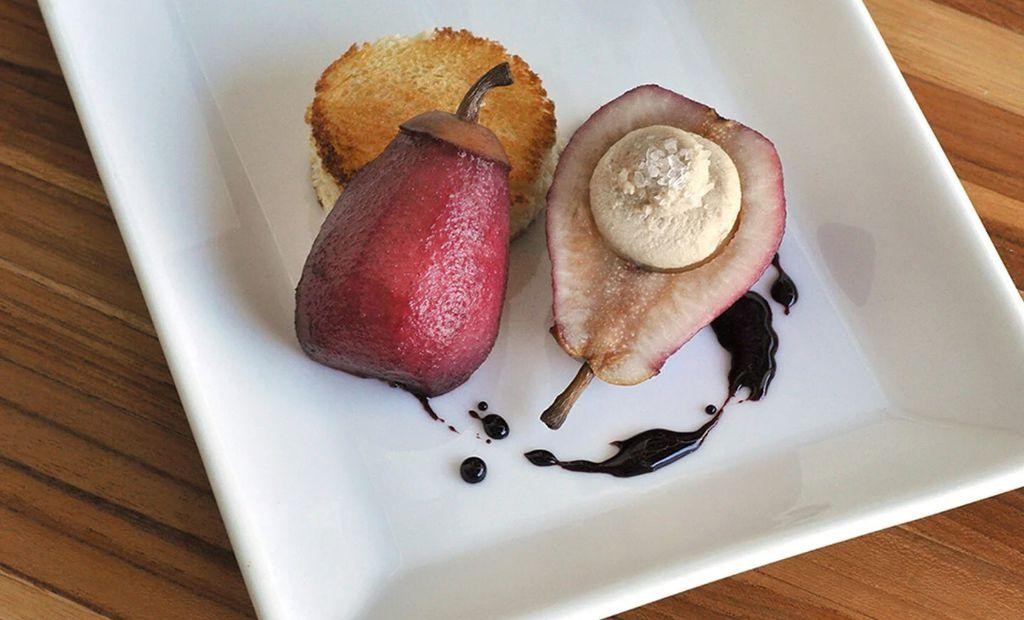
Velvety and sophisticated, these port and fig poached pears transform humble fruit into an elegant dessert worthy of any special occasion. The deep ruby port wine infuses each pear with rich, complex flavors while dried figs add natural sweetness and subtle texture. This stunning dessert requires minimal effort but delivers maximum impression, making it perfect for dinner parties or holiday gatherings.
3
portions15
minutes42
minutesIngredients
Pear – 4
Port wine – 2 cups
Dried fig – ½ cup
Sugar – ¼ cup
Cinnamon stick – 1
Instructions
1. Peel 4 pears completely, leaving the stems intact for elegant presentation.
2. Use a melon baller to carefully core each pear from the bottom, removing seeds while keeping the fruit intact.
3. Combine 2 cups port wine, ½ cup dried figs, ¼ cup sugar, and 1 cinnamon stick in a saucepan large enough to hold all pears upright.
4. Bring the liquid to a simmer over medium heat, stirring until sugar dissolves completely.
5. Gently place peeled pears into the simmering liquid, ensuring they’re fully submerged.
6. Cover the saucepan and reduce heat to maintain a gentle simmer for 25-30 minutes.
7. Test pear doneness by inserting a paring knife into the thickest part – it should slide in with minimal resistance.
8. Remove saucepan from heat and let pears cool in the poaching liquid for 1 hour to absorb maximum flavor.
9. Transfer pears to serving plates using a slotted spoon to prevent breaking.
10. Strain the poaching liquid through a fine-mesh sieve into a clean saucepan.
11. Bring the strained liquid to a boil over high heat and reduce by half, about 10-12 minutes, until it coats the back of a spoon.
12. Spoon the reduced port syrup over each pear just before serving.
Exquisitely tender yet holding their shape, these pears offer a beautiful contrast between the delicate fruit and the intense, spiced port reduction. The figs become plump and jam-like during poaching, creating pockets of concentrated sweetness throughout. For an extra touch of luxury, serve with a dollop of crème fraîche or alongside a sharp blue cheese to balance the dessert’s natural sweetness.
Port Reduction Sauce for Steaks
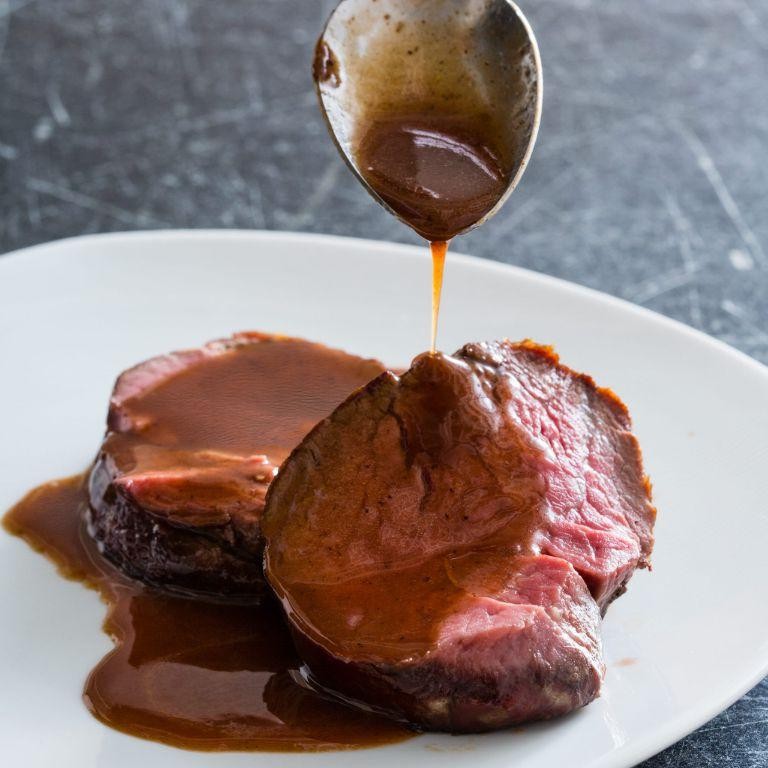
Perfectly complementing a beautifully seared steak, this port reduction sauce transforms simple pan drippings into an elegant, deeply flavored accompaniment. Its rich, complex sweetness balances the savory char of the meat, creating a restaurant-quality finish right in your own kitchen. This straightforward method yields a glossy, intensely flavored sauce that elevates any cut from ordinary to extraordinary.
2
servings5
minutes20
minutesIngredients
- Port Wine – 1 cup
- Beef Broth – 1 cup
- Unsalted Butter – 2 tbsp
- Shallot – 1, minced
- Fresh Thyme – 2 sprigs
Instructions
- After cooking your steak, pour off all but 1 tablespoon of fat from the pan, leaving the browned bits intact.
- Add the minced shallot to the hot pan and cook over medium heat for 2 minutes, stirring constantly until softened and fragrant.
- Pour in the port wine, using a wooden spoon to scrape up all the browned bits from the bottom of the pan—this technique, called deglazing, incorporates the flavorful fond into the sauce.
- Add the fresh thyme sprigs and bring the mixture to a steady simmer over medium-high heat.
- Cook for 8–10 minutes, until the port has reduced by half and the liquid appears slightly syrupy when you drag a spoon across the pan.
- Pour in the beef broth and return the sauce to a simmer, cooking for another 6–8 minutes until it thickens enough to coat the back of a spoon.
- Remove the pan from heat and discard the thyme sprigs, as leaving them in longer can make the sauce bitter.
- Whisk in the unsalted butter, one tablespoon at a time, until fully incorporated and the sauce becomes glossy and emulsified—this final enrichment, called mounting with butter, gives the sauce its velvety texture.
- Season the sauce lightly with salt only at the end, as reducing concentrates flavors and early salting can make it overly salty.
When finished, this reduction boasts a luxurious, velvety texture that clings beautifully to each slice of steak. The deep, fruity complexity of the port melds with the savory beef essence, creating layers of flavor that enhance without overpowering. For a creative twist, try drizzling it over grilled portobello mushrooms or using it as a base for a sophisticated pan sauce for pork tenderloin.
Mushroom Risotto with Port Wine
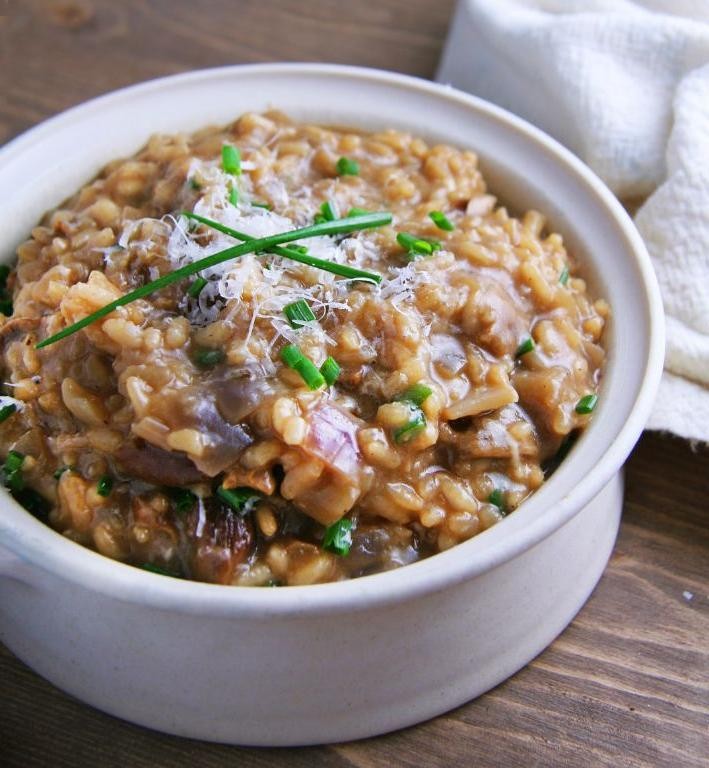
Heralding the arrival of autumn, this Mushroom Risotto with Port Wine transforms humble ingredients into a luxurious celebration of earthy flavors. The deep, rich notes of port wine elevate the creamy arborio rice and sautéed mushrooms into a sophisticated yet comforting dish perfect for crisp evenings. Each spoonful delivers a harmonious balance of textures and aromas that speaks to the season’s bounty.
5
servings15
minutes35
minutesIngredients
Arborio rice – 1 ½ cups
Mixed mushrooms – 8 oz
Shallot – 1 large
Garlic – 2 cloves
Port wine – ½ cup
Vegetable broth – 4 cups
Butter – 3 tbsp
Parmesan cheese – ½ cup grated
Salt – 1 tsp
Black pepper – ½ tsp
Instructions
1. Heat 2 tablespoons of butter in a large skillet over medium heat until melted and foaming.
2. Add sliced mushrooms and cook for 6-8 minutes until golden brown and moisture has evaporated.
3. Finely chop shallot and garlic while mushrooms cook to ensure even cooking.
4. Push mushrooms to the side of the skillet and add remaining 1 tablespoon of butter to the empty space.
5. Sauté shallot and garlic in the butter for 2 minutes until fragrant and translucent.
6. Add arborio rice to the skillet and toast for 1 minute, stirring constantly to coat each grain with butter.
7. Pour port wine into the skillet and cook for 2 minutes until mostly absorbed, scraping any browned bits from the bottom.
8. Heat vegetable broth in a separate saucepan until simmering at 180°F to maintain consistent cooking temperature.
9. Add 1 cup of hot broth to the rice mixture and stir continuously until liquid is fully absorbed, about 4-5 minutes.
10. Continue adding broth ½ cup at a time, stirring constantly and waiting for each addition to be absorbed before adding the next.
11. Test rice texture after 18 minutes – it should be creamy with a slight firmness at the center.
12. Stir in grated Parmesan cheese until melted and fully incorporated into the risotto.
13. Season with salt and black pepper, stirring to distribute evenly throughout the dish.
14. Remove from heat and let rest for 2 minutes to allow flavors to meld.
Buttery and luxurious, this risotto achieves the perfect al dente texture where each grain maintains its structure while swimming in a velvety sauce. The port wine reduction creates a beautiful burgundy hue and adds complex sweetness that complements the earthy mushrooms beautifully. For an elegant presentation, garnish with fresh thyme sprigs and shaved Parmesan, serving immediately while the risotto maintains its creamy consistency.
Port Wine and Blue Cheese Risotto
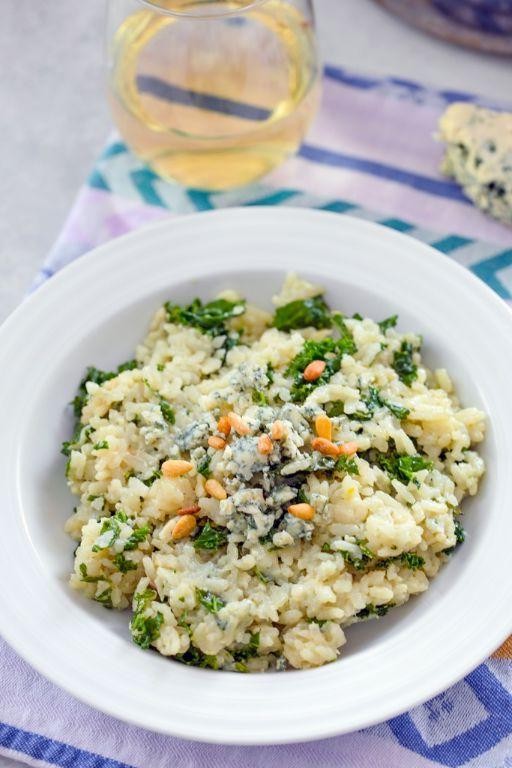
Nestled between the worlds of rustic Italian tradition and sophisticated wine country cuisine, this port wine and blue cheese risotto offers a luxurious twist on a classic comfort dish. The deep, fruity notes of port wine meld beautifully with the bold tang of blue cheese, creating a rich, complex flavor profile that feels both elegant and deeply satisfying. Each creamy spoonful delivers a perfect balance of earthy grains and decadent toppings that will transport your dinner table straight to a fine dining experience.
3
servings10
minutes35
minutesIngredients
Arborio rice – 1 ½ cups
Chicken broth – 4 cups
Port wine – ¾ cup
Blue cheese – 4 oz
Butter – 3 tbsp
Shallot – 1 medium
Olive oil – 2 tbsp
Salt – 1 tsp
Instructions
1. Pour chicken broth into a medium saucepan and heat over medium heat until it reaches a gentle simmer, then reduce heat to low to maintain warmth throughout cooking.
2. Finely dice the shallot into uniform ¼-inch pieces to ensure even cooking and consistent flavor distribution.
3. Heat olive oil in a large, heavy-bottomed pot over medium heat for 1 minute until the oil shimmers but doesn’t smoke.
4. Add diced shallot to the hot oil and cook for 3-4 minutes, stirring constantly with a wooden spoon, until the pieces become translucent and fragrant.
5. Add Arborio rice to the pot and toast for 2 minutes, stirring continuously, until the grains become slightly translucent around the edges.
6. Pour port wine into the rice mixture and stir constantly until the liquid is completely absorbed, which should take approximately 2-3 minutes.
7. Add ½ cup of warm chicken broth to the rice and stir continuously until the liquid is fully absorbed before adding the next ½ cup, repeating this process for 25-30 minutes until all broth is incorporated. Tip: Maintain a steady, gentle simmer throughout this process to release the rice’s starches gradually for optimal creaminess.
8. Test the rice texture by tasting a grain—it should be tender but still have a slight firmness at the center, known as al dente.
9. Remove the pot from heat and let it rest for 1 minute to allow the temperature to stabilize before adding dairy.
10. Crumble blue cheese into small, pea-sized pieces for even melting and distribution throughout the risotto.
11. Add butter and crumbled blue cheese to the risotto and stir vigorously for 1-2 minutes until the cheese melts completely and the risotto develops a creamy, cohesive texture. Tip: This vigorous stirring, called mantecatura, creates the signature creamy consistency that defines excellent risotto.
12. Season with salt and stir for 30 seconds to incorporate evenly throughout the dish. Tip: Always salt at the end when making risotto with cheese, as the cheese contributes its own saltiness and early seasoning can make the final dish too salty.
13. Serve immediately in warm bowls to maintain the ideal creamy texture. For an elegant presentation, garnish with additional blue cheese crumbles and a drizzle of reduced port wine. The finished risotto should have a luxurious, flowing consistency that slowly spreads on the plate rather than holding a stiff shape.
Port Wine Chocolate Truffles

Zesty yet sophisticated, these port wine chocolate truffles blend the rich complexity of fortified wine with the velvety depth of dark chocolate. Perfect for holiday gatherings or as an elegant homemade gift, they require minimal ingredients but deliver maximum indulgence. Their deep ruby hue and glossy finish make them as beautiful as they are delicious.
24
truffles15
minutes4
minutesIngredients
Dark chocolate – 8 oz
Heavy cream – ½ cup
Port wine – ¼ cup
Cocoa powder – ¼ cup
Instructions
1. Chop 8 oz of dark chocolate into uniform small pieces using a sharp knife and place in a heatproof bowl.
2. Pour ½ cup of heavy cream into a small saucepan and heat over medium heat until small bubbles form around the edges, about 3-4 minutes.
3. Immediately pour the hot cream over the chopped chocolate and let it stand undisturbed for 2 minutes to melt the chocolate.
4. Whisk the chocolate and cream mixture in one direction until completely smooth and glossy, about 1-2 minutes.
5. Stir in ¼ cup of port wine until fully incorporated into the chocolate ganache.
6. Cover the bowl with plastic wrap, pressing it directly onto the surface of the ganache to prevent a skin from forming.
7. Refrigerate the ganache for exactly 2 hours until firm but still pliable, checking at the 1.5-hour mark to avoid over-hardening.
8. Line a baking sheet with parchment paper and scoop tablespoon-sized portions of the chilled ganache using a small cookie scoop.
9. Roll each portion between your palms into smooth, round balls, working quickly to prevent melting from hand heat.
10. Place ¼ cup of cocoa powder in a shallow bowl and roll each truffle until completely coated, tapping gently to remove excess powder.
11. Arrange the finished truffles in a single layer on the prepared baking sheet and refrigerate for 30 minutes to set completely.
Creamy and decadent, these truffles feature a silken interior that melts luxuriously on the tongue, releasing waves of dark chocolate and wine-infused complexity. For an elegant presentation, arrange them in miniature paper cups or serve alongside strong coffee to complement their rich flavor profile. Their sophisticated balance makes them particularly memorable when presented as part of a dessert charcuterie board.
Port Infused Beef Stew
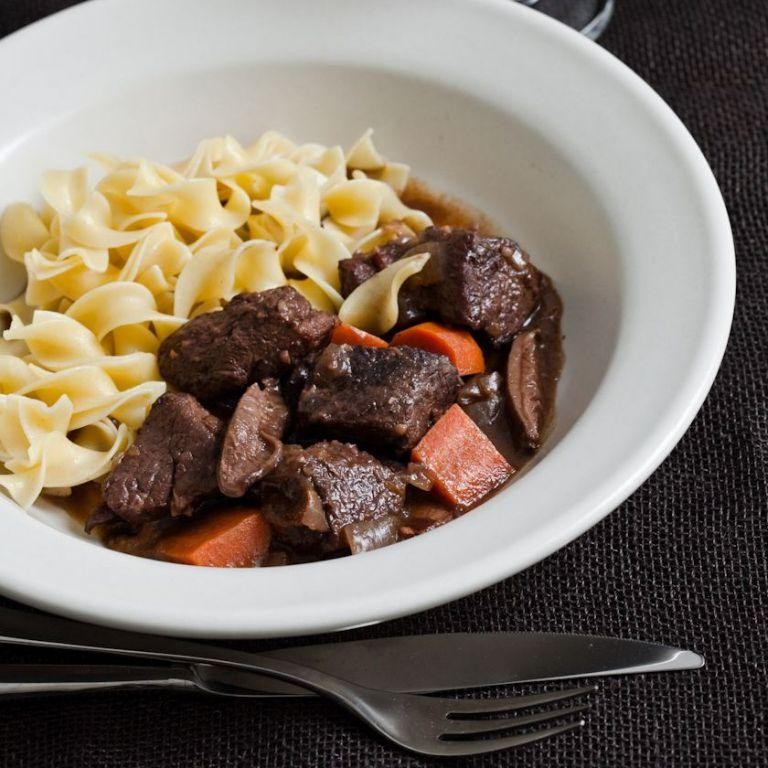
A rich, ruby-hued port wine elevates this classic beef stew into an autumnal masterpiece, where tender chunks of meat melt into a deeply savory sauce that clings lovingly to each vegetable. As the chill of October evenings settles in, this comforting dish becomes the culinary equivalent of a warm embrace, perfect for gathering around the table with loved ones. The complex sweetness of the port balances beautifully with the earthy notes of slow-cooked beef, creating layers of flavor that deepen with every simmering hour.
3
servings25
minutes155
minutesIngredients
– Beef chuck – 2 lbs
– Olive oil – 2 tbsp
– Yellow onion – 1 large
– Carrots – 3 medium
– Port wine – 1 cup
– Beef broth – 4 cups
– Tomato paste – 2 tbsp
– Thyme – 1 tsp
– Salt – 1 tsp
– Black pepper – ½ tsp
Instructions
1. Cut the beef chuck into 1-inch cubes, patting them completely dry with paper towels to ensure proper browning.
2. Heat 2 tablespoons of olive oil in a large Dutch oven over medium-high heat until it shimmers, about 2 minutes.
3. Sear the beef cubes in a single layer without crowding, turning each piece until all sides develop a deep brown crust, approximately 8-10 minutes total.
4. Transfer the seared beef to a clean plate, leaving the fond and drippings in the pot.
5. Dice the yellow onion into ½-inch pieces and add them to the hot pot, stirring constantly until translucent and lightly golden, about 5 minutes.
6. Slice the carrots into ½-inch rounds and add them to the pot, cooking for 3 minutes until slightly softened.
7. Pour in 1 cup of port wine, using a wooden spoon to scrape all the browned bits from the bottom of the pot—this technique, called deglazing, captures maximum flavor.
8. Stir in 2 tablespoons of tomato paste and cook for 1 minute until it darkens slightly and becomes fragrant.
9. Return the seared beef and any accumulated juices to the pot along with 4 cups of beef broth.
10. Add 1 teaspoon of thyme, 1 teaspoon of salt, and ½ teaspoon of black pepper, stirring gently to combine.
11. Bring the stew to a gentle boil, then immediately reduce the heat to low and cover with a tight-fitting lid.
12. Simmer for 2 hours and 15 minutes, resisting the urge to stir frequently as this breaks down the beef too much.
13. After cooking, let the stew rest off the heat for 15 minutes—this allows the flavors to marry and the meat fibers to relax for ultimate tenderness.
The resulting stew boasts fall-apart tender beef that yields effortlessly to a fork, while the port-infused sauce coats each vegetable with a glossy, deeply savory richness. For an elegant presentation, serve it in shallow bowls over creamy polenta or with crusty bread to soak up every last drop of the luxurious sauce.
Port Braised Lamb Shanks
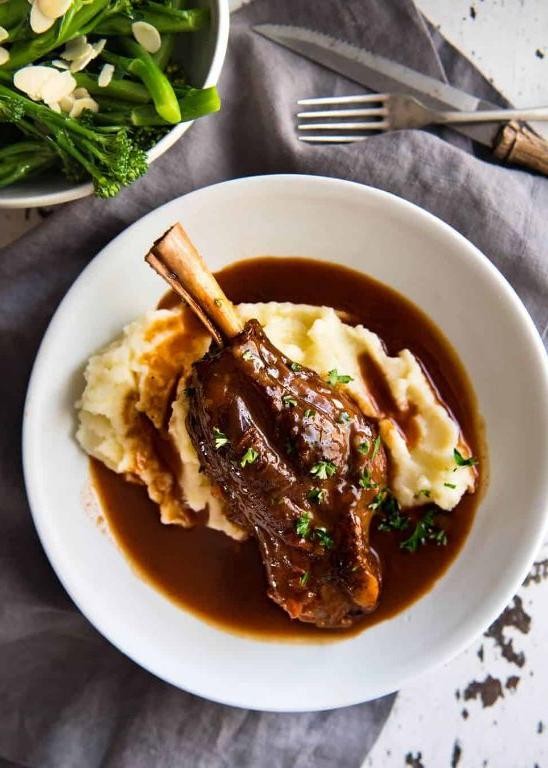
Kindly consider this autumnal masterpiece: port-braised lamb shanks, where slow-cooked meat yields to the gentlest pressure, bathed in a rich, ruby-hued reduction that marries the deep fruitiness of fortified wine with aromatic herbs.
5
servings20
minutes195
minutesIngredients
Lamb shanks – 4
Salt – 1 tsp
Black pepper – ½ tsp
Flour – ¼ cup
Olive oil – 2 tbsp
Yellow onion – 1, chopped
Carrots – 2, chopped
Garlic – 4 cloves, minced
Port wine – 1 cup
Beef broth – 2 cups
Fresh rosemary – 2 sprigs
Fresh thyme – 4 sprigs
Instructions
1. Preheat your oven to 325°F.
2. Pat the lamb shanks completely dry with paper towels.
3. Season all sides of the lamb shanks evenly with the salt and black pepper.
4. Dredge each lamb shank in the flour, shaking off any excess.
5. Heat the olive oil in a large, oven-safe Dutch oven over medium-high heat until it shimmers.
6. Sear the lamb shanks for 4-5 minutes per side until a deep golden-brown crust forms.
7. Transfer the seared lamb shanks to a clean plate.
8. Add the chopped yellow onion and carrots to the same pot, sautéing for 6-7 minutes until softened.
9. Stir in the minced garlic and cook for 1 minute until fragrant.
10. Pour in the port wine, using a wooden spoon to scrape up any browned bits from the bottom of the pot.
11. Simmer the port for 3-4 minutes until reduced by half.
12. Pour in the beef broth and bring the liquid to a gentle simmer.
13. Return the lamb shanks to the pot, nestling them into the liquid.
14. Submerge the fresh rosemary and thyme sprigs into the braising liquid.
15. Cover the Dutch oven with a tight-fitting lid and transfer it to the preheated oven.
16. Braise for 2 hours and 30 minutes, until the meat is fork-tender and easily pulls away from the bone.
17. Carefully remove the pot from the oven and transfer the lamb shanks to a serving platter.
18. Skim any excess fat from the surface of the braising liquid with a spoon.
19. Simmer the remaining liquid on the stovetop over medium heat for 8-10 minutes until it thickens to a sauce-like consistency.
20. Strain the sauce through a fine-mesh sieve, pressing on the solids to extract all flavor.
This dish achieves a sublime texture where the meat falls from the bone at the slightest touch, enveloped in a sauce that balances the port’s inherent sweetness with savory depth. Try serving these shanks over a bed of creamy polenta or alongside roasted root vegetables to complement the rich, aromatic braise.
Port Wine Cheesecake

Luxuriously rich and sophisticated, this port wine cheesecake marries the deep, fruity complexity of fortified wine with the creamy indulgence of classic cheesecake. The ruby-hued reduction creates a stunning marbled effect throughout the velvety filling, while a buttery graham cracker crust provides the perfect textural contrast. This elegant dessert transforms simple ingredients into a showstopping finale worthy of any special occasion.
8
servings30
minutes60
minutesIngredients
Graham crackers – 1½ cups crushed
Unsalted butter – 5 tbsp
Granulated sugar – ¾ cup
Cream cheese – 24 oz
Eggs – 3
Port wine – 1 cup
Heavy cream – ½ cup
Instructions
1. Preheat your oven to 325°F and grease a 9-inch springform pan.
2. Combine crushed graham crackers with 3 tablespoons melted butter and ¼ cup sugar in a medium bowl.
3. Press the crumb mixture firmly into the bottom of the prepared pan using the bottom of a measuring cup to create an even layer.
4. Bake the crust for 10 minutes at 325°F until lightly golden, then cool completely on a wire rack.
5. Meanwhile, reduce 1 cup port wine in a small saucepan over medium heat until it measures ¼ cup, about 12-15 minutes, watching carefully to prevent burning.
6. Cool the port reduction to room temperature, which helps prevent cracking when added to the cheesecake batter.
7. Beat cream cheese with remaining ½ cup sugar in a large bowl using an electric mixer on medium speed until completely smooth, about 2 minutes.
8. Add eggs one at a time, beating just until incorporated after each addition to avoid overmixing.
9. Stir in heavy cream and cooled port reduction until the batter is uniformly colored.
10. Pour the filling over the cooled crust and smooth the top with a spatula.
11. Bake at 325°F for 45-50 minutes until the edges are set but the center still jiggles slightly when gently shaken.
12. Turn off the oven and prop the door open with a wooden spoon, letting the cheesecake cool gradually inside for 1 hour to prevent surface cracks.
13. Refrigerate the cheesecake for at least 6 hours, preferably overnight, to fully set before serving.
Unveiling this masterpiece reveals a stunning marbled interior where the port wine creates beautiful swirls throughout the creamy canvas. The finished cheesecake boasts a velvety texture that melts luxuriously on the tongue, with the port reduction lending subtle fruity notes that complement the rich cream cheese base. For an elegant presentation, serve thin slices with a drizzle of reduced port syrup and fresh berries to highlight the wine’s complex flavor profile.
Figs in Port Wine with Mascarpone

Kindly consider this sophisticated dessert that transforms humble figs into an elegant finale. Plump figs gently poached in rich port wine create a luxurious syrup that perfectly complements creamy mascarpone. This effortless yet impressive dish embodies autumnal elegance in every spoonful.
5
portions10
minutes25
minutesIngredients
Figs – 1 lb
Port wine – 1 cup
Sugar – ¼ cup
Mascarpone – 8 oz
Instructions
1. Rinse 1 lb of fresh figs under cool running water and pat them completely dry with paper towels.
2. Using a sharp paring knife, carefully slice each fig in half lengthwise from stem to base.
3. Combine 1 cup of port wine and ¼ cup of sugar in a medium saucepan over medium heat.
4. Stir the mixture continuously with a wooden spoon until the sugar completely dissolves, about 2-3 minutes.
5. Gently place the halved figs into the saucepan, arranging them in a single layer cut-side down.
6. Reduce the heat to low and simmer the figs uncovered for 12-15 minutes until they become tender but still hold their shape.
7. Carefully transfer the poached figs to a serving dish using a slotted spoon, preserving the port syrup in the pan.
8. Increase the heat to medium-high and boil the remaining port syrup for 5-7 minutes until it thickens to a honey-like consistency.
9. Spoon the warm port syrup evenly over the arranged figs in the serving dish.
10. Dollop 8 oz of mascarpone cheese in generous spoonfuls alongside the figs.
Beautifully tender figs absorb the deep, wine-infused syrup while maintaining their delicate structure. The velvety mascarpone provides a cool, creamy contrast to the warm fruit, creating a sophisticated balance of textures. Serve this elegant dessert in shallow bowls with crisp biscotti for dipping into the remaining port reduction.
Port-Marinated Grilled Mushrooms
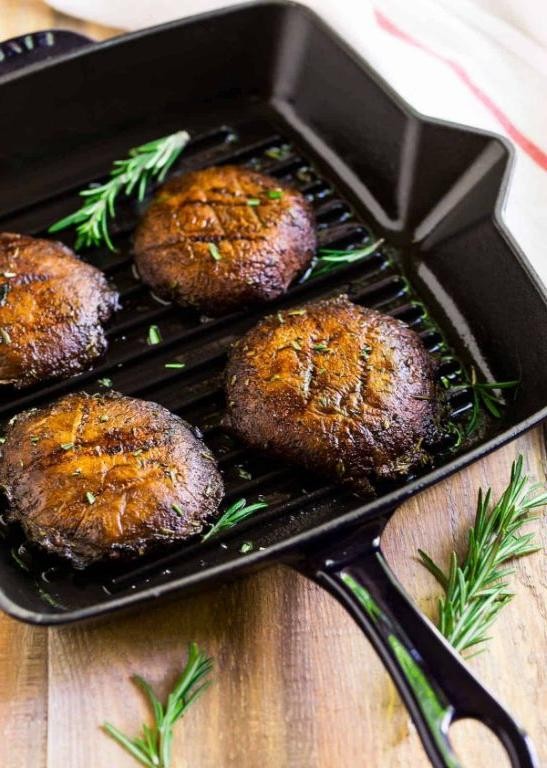
Just as autumn’s crisp air settles in, these port-marinated grilled mushrooms emerge as a sophisticated yet approachable centerpiece, blending earthy depth with a whisper of sweet, fortified wine. Juicy and richly glazed, they transform humble fungi into an elegant dish perfect for gatherings or a quiet evening. Their savory aroma and caramelized edges promise to captivate both palate and plate.
5
portions50
minutes12
minutesIngredients
- Port wine – ½ cup
- Olive oil – 2 tbsp
- Garlic – 2 cloves, minced
- Fresh thyme – 1 tbsp
- Cremini mushrooms – 1 lb, stems trimmed
- Salt – ½ tsp
- Black pepper – ¼ tsp
Instructions
- In a medium bowl, whisk together ½ cup port wine, 2 tbsp olive oil, 2 minced garlic cloves, 1 tbsp fresh thyme, ½ tsp salt, and ¼ tsp black pepper until fully combined.
- Add 1 lb cremini mushrooms to the marinade, tossing gently to coat each mushroom evenly.
- Cover the bowl and refrigerate for 45 minutes to allow the flavors to penetrate the mushrooms deeply.
- Preheat a grill or grill pan to medium-high heat, about 400°F, and lightly oil the grates to prevent sticking.
- Remove the mushrooms from the marinade, shaking off excess liquid, and reserve the remaining marinade in a small saucepan.
- Place the mushrooms on the preheated grill in a single layer, gill-side down, and grill for 4–5 minutes until grill marks appear and edges begin to soften.
- Flip the mushrooms using tongs and grill for another 4–5 minutes until tender and slightly charred.
- Meanwhile, bring the reserved marinade to a boil over medium heat and simmer for 3 minutes to reduce it into a glossy glaze, stirring occasionally.
- Brush the reduced glaze over the grilled mushrooms during the last minute of cooking for a shiny, flavorful finish.
- Transfer the mushrooms to a serving platter and drizzle with any remaining glaze.
With their meaty texture and glossy sheen, these mushrooms boast a balance of umami richness and subtle sweetness from the reduced port. Serve them warm over creamy polenta or alongside a crisp green salad to highlight their elegant depth, making them a versatile star for any autumn table.
Port Wine Sauce for Lamb Chops
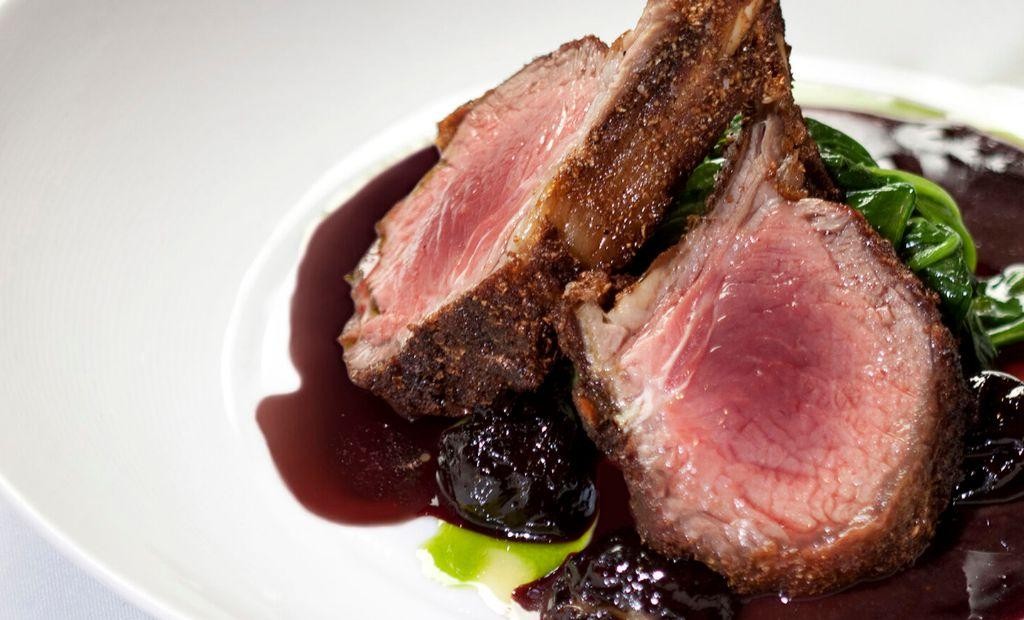
Elegant and deeply flavorful, this port wine sauce transforms simple lamb chops into a restaurant-worthy dish. The rich, ruby-hued reduction glistens with a perfect balance of sweetness and savory depth, creating a luxurious accompaniment that clings beautifully to each tender bite. With just a handful of quality ingredients, this sauce elevates your meal from ordinary to extraordinary in minutes.
2
servings10
minutes25
minutesIngredients
Port Wine – 1 cup
Beef Stock – 1 cup
Shallot – 1, minced
Butter – 2 tbsp
Fresh Thyme – 2 sprigs
Salt – ½ tsp
Black Pepper – ¼ tsp
Instructions
1. Mince 1 shallot finely until it yields approximately 2 tablespoons.
2. Melt 2 tablespoons of butter in a saucepan over medium heat until foaming subsides.
3. Add the minced shallot and cook for 3-4 minutes until translucent and fragrant.
4. Pour 1 cup of port wine into the saucepan, stirring to combine with the shallots.
5. Simmer the port wine mixture for 8-10 minutes until reduced by half, watching for a syrupy consistency.
6. Add 1 cup of beef stock and 2 sprigs of fresh thyme to the reduced port wine.
7. Continue simmering for 12-15 minutes until the sauce coats the back of a spoon.
8. Remove the thyme sprigs from the sauce using tongs.
9. Season the sauce with ½ teaspoon of salt and ¼ teaspoon of black pepper, stirring to incorporate.
10. Strain the sauce through a fine-mesh sieve into a clean container, pressing on the solids.
Keep this sauce warm until ready to serve, as it will thicken slightly upon standing. Known for its velvety texture and complex flavor profile, this port reduction offers notes of dark fruit that complement the lamb’s richness perfectly. Consider drizzling it over roasted root vegetables or using it to enhance beef tenderloin for an equally impressive presentation.
Port and Berry Reduction for Desserts
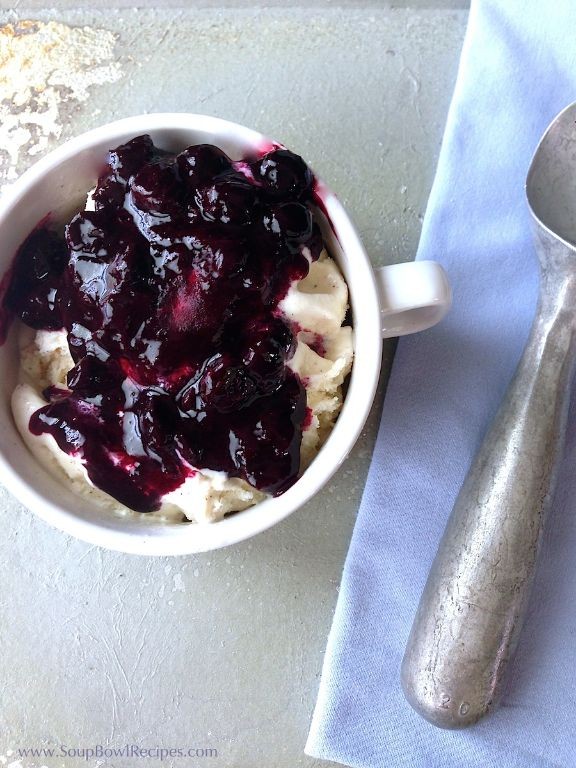
Yielding a sophisticated depth that elevates any dessert, this port and berry reduction transforms simple sweets into elegant finales. The rich, fruity syrup marries the complexity of fortified wine with the bright acidity of mixed berries, creating a versatile topping that complements everything from cheesecake to ice cream. Its glossy finish and intense flavor profile make it an indispensable addition to your dessert repertoire.
1
jar5
minutes47
minutesIngredients
Port wine – 1 cup
Mixed berries – 2 cups
Granulated sugar – ½ cup
Lemon juice – 1 tbsp
Instructions
- Combine port wine, mixed berries, and granulated sugar in a medium saucepan over medium heat.
- Bring the mixture to a gentle boil, stirring occasionally with a wooden spoon to dissolve the sugar completely.
- Reduce heat to low and simmer for 20 minutes, allowing the berries to break down and release their juices.
- Stir in lemon juice to balance the sweetness and enhance the berry flavors.
- Continue simmering for another 10 minutes until the mixture reduces by half and thickens to a syrupy consistency.
- Remove the saucepan from heat and let the reduction cool for 5 minutes.
- Pour the mixture through a fine-mesh strainer into a clean bowl, pressing gently on the solids with the back of a spoon to extract all liquid.
- Discard the berry solids and return the strained liquid to the saucepan.
- Simmer over medium-low heat for 5-7 minutes until the reduction coats the back of a spoon and reaches 220°F on a candy thermometer.
- Transfer the finished reduction to a glass jar and cool completely before refrigerating.
The resulting reduction boasts a velvety texture that drapes beautifully over desserts, with concentrated berry notes deepened by the port’s oak-aged complexity. Drizzle it over vanilla bean panna cotta for a dramatic contrast, or swirl it into whipped cream for an instant berry-infused topping that elevates simple pound cake to restaurant-quality status.
Conclusion
Elevate your culinary adventures with these 25 gourmet port recipes! From rich sauces to decadent desserts, there’s something for every home cook to explore. We hope you’ll try these delicious creations, share your favorites in the comments below, and pin your must-make dishes to Pinterest for later. Happy cooking!
